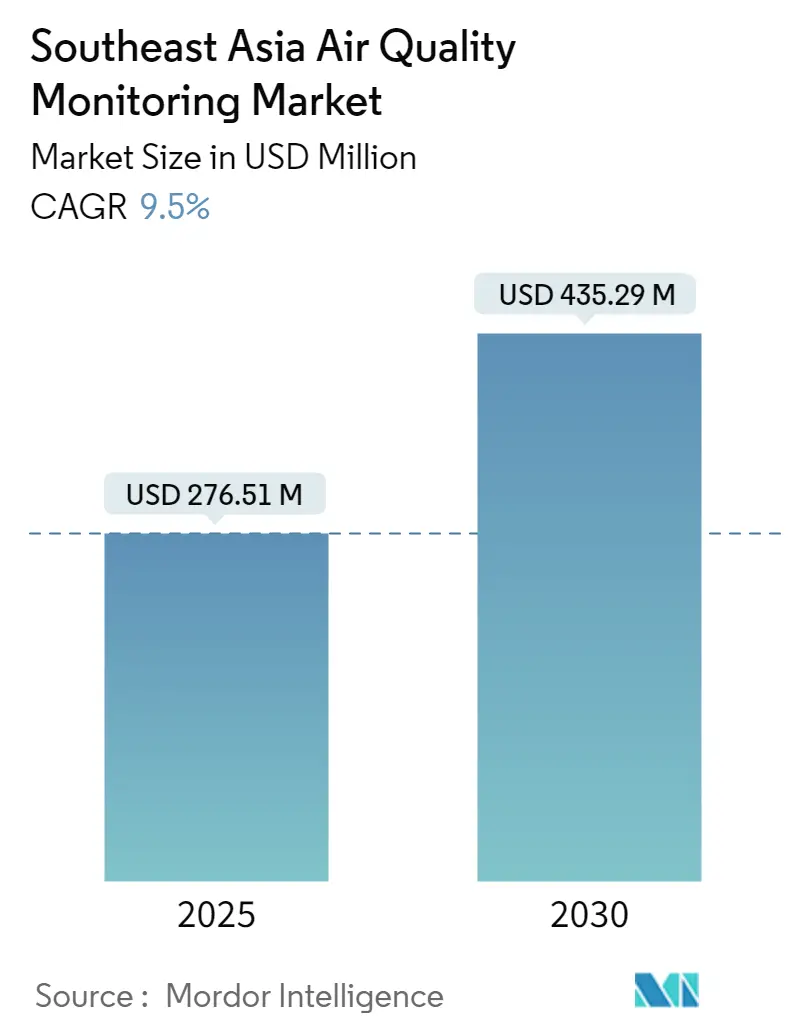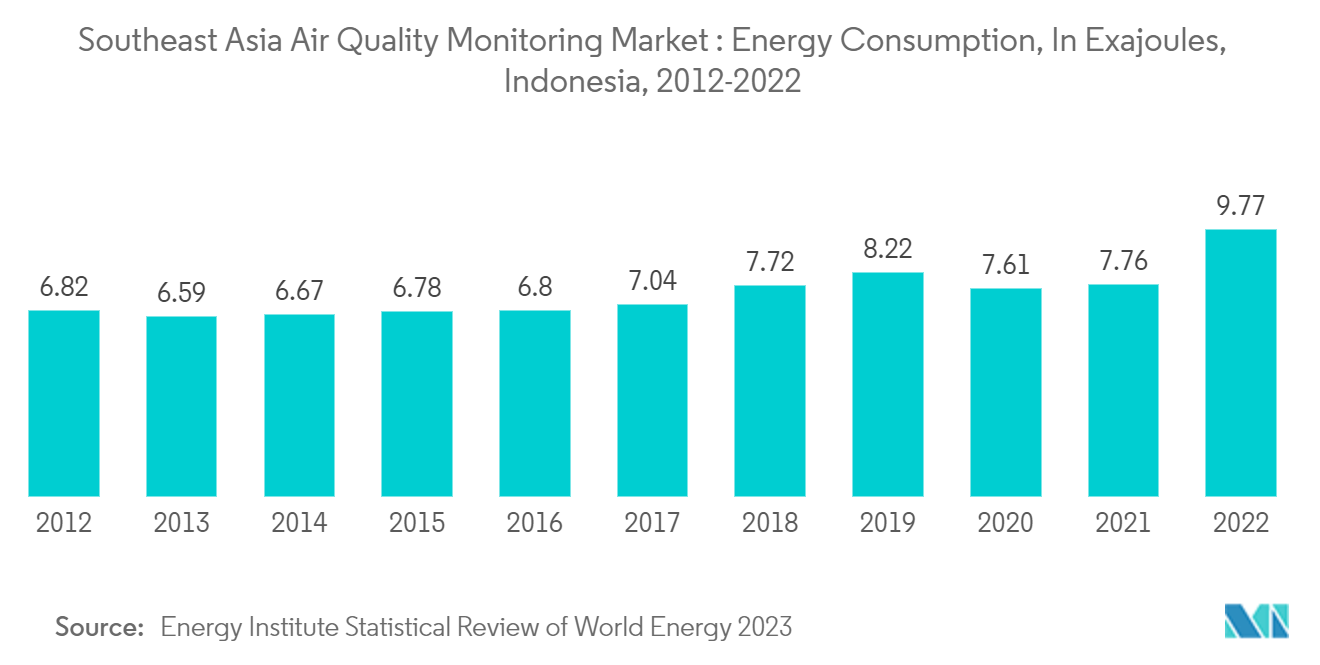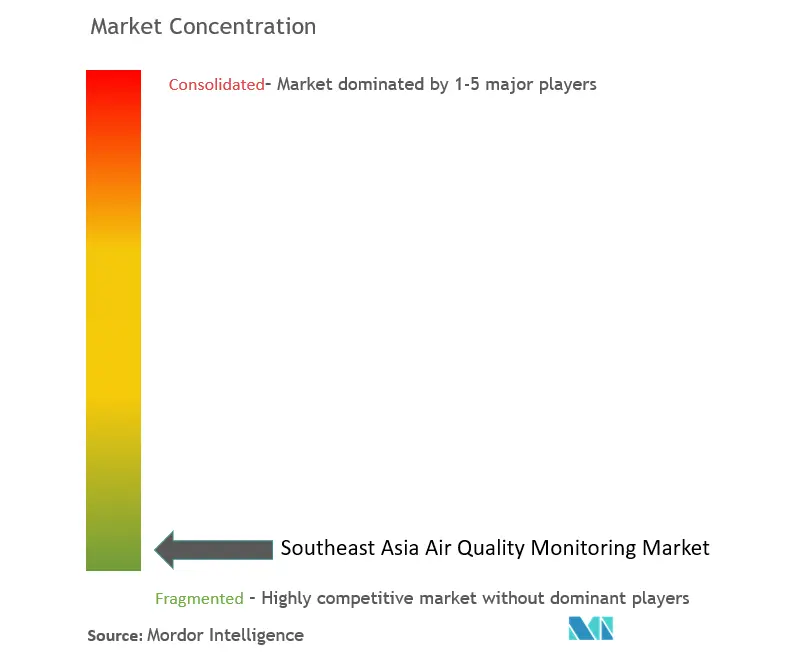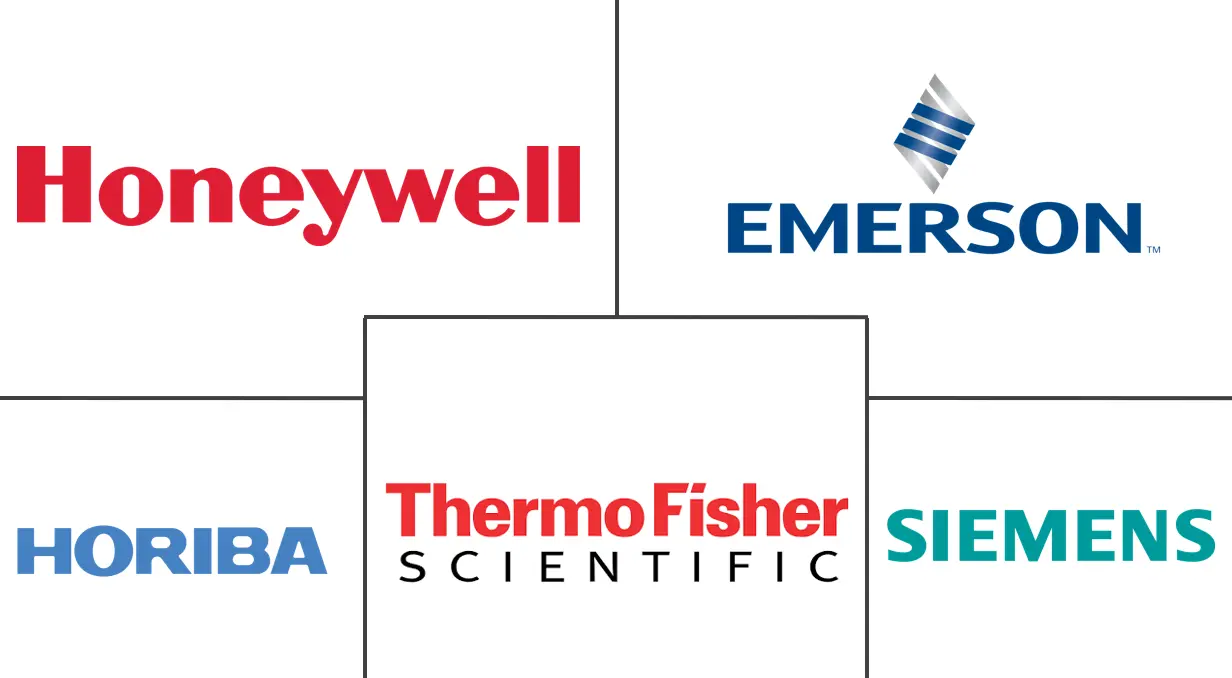Southeast Asia Air Quality Monitoring Market Size and Share

Southeast Asia Air Quality Monitoring Market Analysis by Mordor Intelligence
The Southeast Asia Air Quality Monitoring Market size is estimated at USD 276.51 million in 2025, and is expected to reach USD 435.29 million by 2030, at a CAGR of 9.5% during the forecast period (2025-2030).
- Over the medium period, increasing industrialization and urbanization are leading to a deterioration in air quality, driving the demand for air quality monitoring and purification, especially in developing countries.
- On the other hand, the penetration of renewable and greener energy to support the government's net zero carbon emission policy is expected to hinder the market in the forecast period.
- The technological advancements in air quality monitoring systems create enormous opportunities for the techno-development of devices and their applications. For instance, the recent IoT-based equipment, which is more interactive in its functioning and uses new technologies for communicating and delivering data, is in vogue these days. They are termed the Next Generation Air Quality Monitoring Systems, becoming the research subject for many R&D professionals in the area.
- Indonesia is expected to dominate the Southeast Asia air quality monitoring market as the country holds the majority share in primary energy consumption.
Southeast Asia Air Quality Monitoring Market Trends and Insights
The Outdoor Monitor Segment is Expected to be the Fastest growing Segment
- Outdoor air quality monitoring systems are installed to track the air pollution caused by the transport sector, industrial sector, construction activities, and all other external sources of pollution. The air outside the confined spaces is believed to have more harmful pollutants than indoor air due to the points above of sources.
- Outside air quality monitoring devices are deployed to keep track of the air pollution produced by the transportation industry, the manufacturing industry, construction activities, and all other external sources of pollution. Due to the sources above, the air outside enclosed places is thought to contain more dangerous pollutants than interior air.
- Data are gathered using various sensors to detect undesired pollutants or dangerous gases. The collected data can be monitored remotely and stored on a remote server platform with an internet connection.
- For instance, in February 2023, Five pilot schools received Air Quality Monitoring (AQUAMS Project) launched by the Environment Protection Department Sabah and UNICEF received the air quality monitoring devices in Malaysia. The devices will collect air quality data for monitoring and evidence generation. Thus, such types of installation will boost the demand for Outdoor Monitor Segment in the Southeast Asia region.
- Moreover, no exposure to PM2.5 could be called safe, according to the most current research assessing the relationship between air pollution levels and significant health risks. Even low levels of air pollution can cause negative health impacts.
- In 2022, the average PM2.5 concentration (μg/m³) for countries majorly contributing in Southeast Asia were Indonesia, Myanmar, Laos, and Vietnam. Indonesia accounted for 30.4 μg/m³ of PM2.5 concentration.
- Therefore, the outdoor monitor segment is expected to be the fastest-growing segment in the market during the forecast period due to the above points.

Indonesia is expected to dominate the market
- Indonesia has the majority of the production and consumption of oil and gas in Southeast Asia, particularly due to growing industrialization, which has increased chemical pollutants, thereby driving the air quality monitoring market in the forecast period.
- Nevertheless, six nations in Southeast Asia with improved air quality in 2021, headed by Indonesia with a 16% reduction in yearly PM2.5 concentrations, were the main contributors to the decline in PM2.5 levels. Despite the advancements, Indonesia, ranked 17th globally, is the region's most polluted nation, with a 2021 PM2.5 annual concentration that is nearly 30% higher than Myanmar, which is second in the region.
- Moreover, in Southeast Asia, it is estimated that open burning accounts for 5 to 30% in respective countries of all artificial emissions. Seasonal air pollution cycles are produced in the countries due to the practice, which increases the transboundary movement of air pollutants. Thus, creating opportunities for the air quality monitoring market in the forecast period.
- In 2022, Indonesia accounted for 9.77 Exajoules of the total primary energy consumed across Southeast Asia. Fossil fuels, such as oil, natural gas, and coal, accounted for a significant share of the total primary energy consumed in the region in 2022.
- Therefore, owing to the above points, Indonesia is expected to grow significantly during the forecast period.

Competitive Landscape
The Southeast Asia Air Quality Monitoring Market is fragmented. Some of the major players (not in the particular order) include Siemens AG, Thermo Fisher Scientific Inc., Horiba Ltd, Emerson Electric Co., and Honeywell International Inc., among others.
Southeast Asia Air Quality Monitoring Industry Leaders
Siemens AG
Thermo Fisher Scientific Inc.
Horiba Ltd
Emerson Electric Co.
Honeywell International Inc.
- *Disclaimer: Major Players sorted in no particular order

Recent Industry Developments
- April 2022: The General Department of Environment launched Envisoft, which is an application that provides environmental indicators on a mobile platform under the Vietnamese Ministry of Natural Resources and Environment. The department anticipates that the new iOS and Android-compatible application will be a helpful resource for informing the public about the air quality in their local communities.
- February 2022: The national priority development strategy of the Indonesian government included air quality and climate change in the National Mid-Term Plan (RPJMN) 2020-2024. The Ministry of Health issued Decree No. 829/1999 on Housing Health Standards and Regulation No. 1077/2011 on Guidelines for Air Safety in the Household.
Southeast Asia Air Quality Monitoring Market Report Scope
Air quality monitoring includes monitoring the quantity and types of specific contaminants in the ambient and outside air allowing for the systematic, long-term assessment of pollutant levels.
The Southeast Asia Air Quality Monitoring Market is segmented by Product Type (Indoor Monitor and Outdoor Monitor), Sampling Method (Continuous, Manual, and Intermittent), Pollutant Type (Chemical Pollutants, Physical Pollutants, and Biological Pollutants), End User (Residential and Commercial, Power Generation, Petrochemicals, and Other End Users), and Geography ( Indonesia, Myanmar, Vietnam, and rest of Southeast Asia ). The report offers the market size and forecasts in revenue (USD Billion) for all the above segments. For each segment, the market sizing and forecasts have been done on the revenue (USD).
| Indoor Monitor |
| Outdoor Monitor |
| Continuous |
| Manual |
| Intermittent |
| Chemical Pollutants |
| Physical Pollutants |
| Biological Pollutants |
| Residential and Commercial |
| Power Generation |
| Petrochemicals |
| Other End Users |
| Indonesia |
| Myanmar |
| Vietnam |
| Rest of Southeast Asia |
| Product Type | Indoor Monitor |
| Outdoor Monitor | |
| Sampling Method | Continuous |
| Manual | |
| Intermittent | |
| Pollutant Type | Chemical Pollutants |
| Physical Pollutants | |
| Biological Pollutants | |
| End User | Residential and Commercial |
| Power Generation | |
| Petrochemicals | |
| Other End Users | |
| Geography | Indonesia |
| Myanmar | |
| Vietnam | |
| Rest of Southeast Asia | |
Key Questions Answered in the Report
How big is the Southeast Asia Air Quality Monitoring Market?
The Southeast Asia Air Quality Monitoring Market size is expected to reach USD 276.51 million in 2025 and grow at a CAGR of 9.5% to reach USD 435.29 million by 2030.
What is the current Southeast Asia Air Quality Monitoring Market size?
In 2025, the Southeast Asia Air Quality Monitoring Market size is expected to reach USD 276.51 million.
Who are the key players in Southeast Asia Air Quality Monitoring Market?
Siemens AG, Thermo Fisher Scientific Inc., Horiba Ltd, Emerson Electric Co. and Honeywell International Inc. are the major companies operating in the Southeast Asia Air Quality Monitoring Market.
What years does this Southeast Asia Air Quality Monitoring Market cover, and what was the market size in 2024?
In 2024, the Southeast Asia Air Quality Monitoring Market size was estimated at USD 250.24 million. The report covers the Southeast Asia Air Quality Monitoring Market historical market size for years: 2019, 2020, 2021, 2022, 2023 and 2024. The report also forecasts the Southeast Asia Air Quality Monitoring Market size for years: 2025, 2026, 2027, 2028, 2029 and 2030.
Page last updated on:
Southeast Asia Air Quality Monitoring Market Report
Statistics for the 2025 Southeast Asia Air Quality Monitoring market share, size and revenue growth rate, created by Mordor Intelligence™ Industry Reports. Southeast Asia Air Quality Monitoring analysis includes a market forecast outlook for 2025 to 2030 and historical overview. Get a sample of this industry analysis as a free report PDF download.



